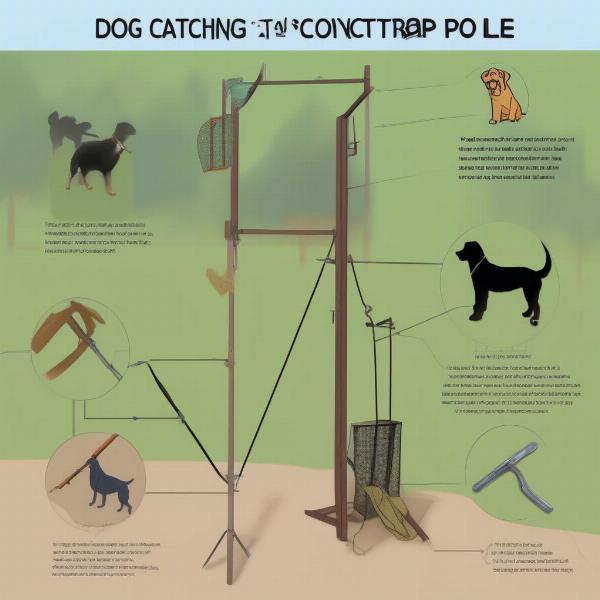Catcher dogs, a term encompassing various tools and techniques used to restrain or capture dogs, often raise questions about their purpose, effectiveness, and ethical implications. Whether you’re dealing with a stray, a lost pet, or a dog exhibiting aggressive behavior, understanding the different types of catcher dogs and their appropriate use is crucial. This article delves into the world of catcher dogs, exploring their various forms, appropriate applications, and the importance of prioritizing humane practices.
 Types of Dog Catcher Tools
Types of Dog Catcher Tools
Different Types of Catcher Dogs
The term “catcher dog” can refer to a few different things: tools designed to capture dogs, the professionals who use these tools, and even specially trained dogs used in certain situations. Let’s break down the most common types:
- Catcher Poles: These poles, also known as control poles, feature a loop at the end designed to safely secure a dog around the neck or body. They offer a safe distance for handling fearful or aggressive dogs.
- Nets: Primarily used for capturing smaller dogs or puppies, nets provide a quick and relatively stress-free method of restraint.
- Humane Traps: These traps are often used for stray or feral dogs. They are designed to lure the dog inside with food and then close gently, containing the animal without causing harm.
- Muzzles: While not strictly for capturing, muzzles are an essential tool for safely handling a captured dog, preventing bites and ensuring the safety of both the handler and the animal.
When are Catcher Dogs Necessary?
Catcher dogs and related tools are vital in various situations, including:
- Rescuing Stray Dogs: Stray dogs often require careful handling and specialized tools for safe capture.
- Retrieving Lost Pets: A frightened lost pet may be difficult to approach, requiring a catcher pole or net for safe retrieval.
- Managing Aggressive Dogs: In situations involving aggressive behavior, catcher dogs and appropriate restraint methods are crucial for public safety.
- Animal Control Operations: Animal control officers rely on these tools to manage dog populations and ensure public health and safety.
Ethical Considerations When Using Catcher Dogs
Using catcher dogs necessitates a humane and responsible approach. Prioritizing the dog’s well-being is paramount.
- Avoid Causing Harm: Catcher dogs should never be used to inflict pain or injury. The goal is safe and gentle restraint.
- Proper Training: Anyone using these tools should be adequately trained in their proper use to minimize stress on the animal.
- Consider the Dog’s Temperament: The appropriate method will vary depending on the dog’s behavior and temperament. A gentle approach is always preferred.
Choosing the Right Catcher Dog Tool
Selecting the right tool depends on the specific situation. Factors to consider include the dog’s size, temperament, and the environment. For instance, a dog catcher pole is often ideal for larger, more apprehensive dogs, while a dog hair drain catcher is essential for maintaining hygiene in your home. A dog pee catcher can be a helpful tool for house-training puppies or managing incontinence in older dogs. If your dog suffers from excessive drooling, a dog drool catcher can help keep your home clean.
Conclusion
Understanding the different types of catcher dogs and their appropriate use is crucial for responsible dog ownership and animal welfare. By prioritizing humane practices and selecting the right tools for each situation, we can ensure the safe and ethical capture and handling of dogs. Remember to always prioritize the animal’s well-being and seek professional assistance when needed. Using a dog urine catcher can also be a valuable tool for monitoring your dog’s health.
FAQ
- What is a catcher dog? A catcher dog can refer to tools, professionals, or even trained dogs used for capturing other dogs.
- When should I use a catcher pole? Catcher poles are useful for safely restraining fearful or aggressive dogs from a distance.
- Are humane traps safe for dogs? Yes, humane traps are designed to capture dogs without causing injury.
- Why is training important when using catcher dogs? Proper training ensures the safe and humane handling of dogs.
- What should I do if I encounter a stray dog? Contact your local animal control or animal shelter.
- How can I choose the right catcher dog tool? Consider the dog’s size, temperament, and the environment.
- Where can I learn more about humane dog capturing techniques? Resources like the ASPCA and the Humane Society offer valuable information.
About ILM Dog
ILM Dog (ilmdog.com) is your trusted resource for expert advice on all aspects of dog care, including breed selection, health, training, nutrition, grooming, and essential products. Whether you’re a seasoned dog owner or just starting your journey, ILM Dog provides practical guidance and valuable insights to help you provide the best possible care for your furry friend. For personalized advice or product recommendations, contact us at [email protected] or +44 20-3965-8624.